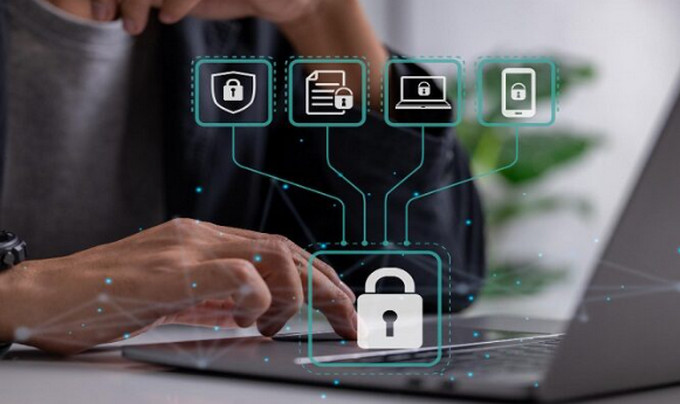
Small businesses face increasing cyber threats. Protecting sensitive data is crucial in today’s digital landscape. Here are essential cybersecurity tips to help safeguard your business data in 2024.
1. Strengthen Your Password Policies
Weak passwords lead to data breaches. Encourage employees to use complex, unique passwords for each account. Additionally, consider implementing a password manager to store credentials securely. Regularly update passwords, especially for high-level access.
2. Implement Two-Factor Authentication (2FA)
Two-factor authentication (2FA) adds a second layer of security to logins. By requiring an additional verification step, you reduce unauthorized access. Whenever possible, enable 2FA on all critical accounts and applications.
3. Educate Employees on Cybersecurity Awareness
Your team is your first line of defense. Regular cybersecurity training helps employees recognize phishing emails and malicious links. Emphasize the importance of security practices and continuously remind them to stay vigilant.
4. Use Firewalls to Block Unwanted Traffic
Firewalls filter out malicious traffic before it reaches your network. They act as a barrier against cyber threats. Ensure firewalls are installed and properly configured on all devices and servers.
5. Keep Software and Systems Updated
Outdated software can contain vulnerabilities. Cybercriminals often exploit these weaknesses to gain access. Regularly updating software and systems ensures you’re protected against the latest threats.
6. Secure Wi-Fi Networks
Unsecured Wi-Fi networks can be easy entry points for hackers. Use strong passwords and encryption for all networks. Avoid using public Wi-Fi for sensitive business tasks whenever possible.
7. Limit Access Based on Roles
Grant data access based on each employee’s role. Restrict access to sensitive information for only those who need it. This reduces the risk of internal data breaches and unauthorized access.
8. Back Up Your Data Regularly
Regular backups prevent data loss in the event of a breach or hardware failure. Store backups in secure, offsite locations. Test recovery procedures to ensure data can be quickly restored when needed.
9. Monitor for Suspicious Activity
Invest in software that monitors network activity and alerts you to unusual behavior. Automated alerts help detect breaches early. The faster you respond, the less damage your business suffers.
10. Use Encryption to Protect Sensitive Data
Encryption scrambles data, making it unreadable to unauthorized users. Encrypt sensitive files, emails, and customer information. Even if data is accessed, encryption renders it useless to attackers.
11. Establish a Cybersecurity Policy
Create a comprehensive cybersecurity policy outlining acceptable practices. Define procedures for data handling, password management, and security protocol. Regularly review and update your policy as cybersecurity risks evolve.
12. Plan for Incident Response
Despite precautions, breaches can still happen. An incident response plan helps you react swiftly and effectively. Outline steps for identifying, containing, and resolving breaches. Make sure all team members know their roles in case of a security incident.
13. Regularly Audit Your Security Measures
Cybersecurity needs constant attention. Regularly audit your current security practices to identify gaps or outdated methods. Consider hiring a cybersecurity expert to review and improve your strategies.
14. Use Antivirus and Anti-Malware Software
Antivirus and anti-malware software protect against malicious attacks. Ensure these programs are installed on all devices. Keep the software updated to safeguard against evolving threats.
15. Limit the Use of Personal Devices
Employees’ personal devices may lack strong security features. Limit the use of personal devices for business tasks to reduce risks. If personal devices are necessary, require antivirus software and encryption.
16. Beware of Phishing Scams
Phishing attacks target individuals with fake emails or messages to obtain sensitive data. Educate employees to recognize phishing attempts. When in doubt, they should avoid clicking on links or downloading attachments.
17. Protect Against Ransomware Attacks
Ransomware locks data until a ransom is paid. Regular backups and employee training can reduce risks. Anti-ransomware tools can also identify and neutralize threats before they cause harm.
18. Use Multi-Layered Security Solutions
Relying on one security method is insufficient. Combine firewalls, antivirus software, and monitoring tools for comprehensive protection. Multi-layered solutions make it harder for cybercriminals to access your data.
19. Consider Cybersecurity Insurance
Cyber insurance covers losses in the event of a cyberattack. For small businesses, it offers financial protection from potential damages. Review policies to ensure they meet your business needs.
20. Partner with a Managed Security Service Provider (MSSP)
MSSPs offer expert security management for businesses with limited IT resources. They monitor, protect, and manage cybersecurity. With their help, small businesses get expert-level protection without significant investment.
Conclusion
Cybersecurity is a critical aspect of small business operations. With these strategies, you can protect your data and your customers. Stay proactive, educate your team, and regularly review your cybersecurity practices. In today’s landscape, safeguarding data is a business imperative.
